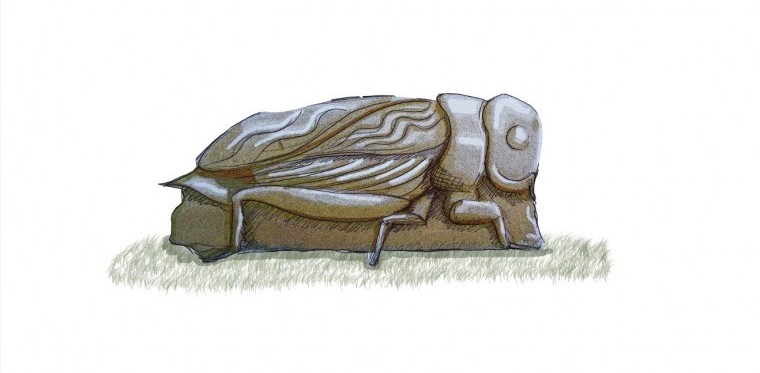Intricate pieces of art that tell the story of the history, wildlife and people of heathlands have been designed for an exciting new educational trail in the South Downs National Park.
Inspired by stories from communities and drawing upon sources as diverse as the poet Tennyson and a 394-year-old local map, award-winning sculptor Graeme Mitcheson has created seven bespoke stone carvings for the South Downs Heathland Trail.
The trail will link seven heathland sites in the National Park to tell the story of why heaths are so important – as commonland enjoyed by local people throughout the centuries and as a rich haven for biodiversity, including rare insects and all 12 of Britain’s native reptiles and amphibians.
The Heathlands Reunited team are working with the RSPB, National Trust, Hampshire County Council and Sussex Wildlife Trust to link up heaths at Wiggonholt, Stedham Common, Lavington Plantation, Shortheath Common, Graffham Common, Black Down and Woolbeding.
Graeme has spent the past six months working with trained volunteers who collected oral histories and carried out archive research with the local community, including groups and schoolchildren.
One of the carving designs, named the “Sheeppig”, is inspired by a map of the Graffham area that was drawn in 1629, during the reign of Charles 1, showing the heath as commonland.
The beautiful map, introduced to Graeme by a Sussex Wildlife Trust reserve manager during a tour of the area, features tiny drawings of animals appearing to be standing on top of one another. A volunteer from the project then found the original archive copy of the map in the West Sussex Records office and Graeme now intends to create a replica of the drawing in carved sandstone.
Graeme said: “The ‘Sheeppig’ is probably the most unusual of all the designs and will reflect the former use of the heath as grazing land, while also paying homage to this amazing centuries-old local map.
“Each and every piece has been inspired by the heritage of local communities and will aim to convey their unique stories for future generations to enjoy.
“We have chosen sandstone that will blend visually with other stone and sand on the heathlands. These tactile artworks will engage the viewer on a number of levels and take much inspiration from the natural world.”
The seven pieces of art are:
Black Down – Tennyson Quote
Probably the most famous admirer of the common and nearby former resident was poet Alfred Lord Tennyson. This carving is inspired by some of his words.
Graffham – Sheeppig
This sculpture will reflect the former use of the site as grazing land but also refers to the rare map of the vicinity. The piece will stand around 4ft high and be carved from sandstone.
Lavington – Lizard
Inspired by the oral histories detailing the abundance of snake and lizard species that thrive on the common. The low-lying carving will be quite subtle in the summer months with longer grass, but will become more apparent in the winter as grass die away. The sculpture can also function as a seat for people as they end their walk.
Stedham – Dragonflies Rest
Paying homage to the importance of insects to the commons at Stedham, the design is a sculptural seat inspired by insect wings. The simple but elegant carved stone bench will rise and twist at either side in a manner similar to dragonfly wings.
Woolbeding – Resting Reptiles
Inspired by stories of grass snakes, adders and slow worms on the heathlands, as well as the many Oak and Birch trees not found at other heathland sites. Located in a wooded area and adjacent to the Serpent Trail, two sculptures are planned, each containing a different type of snake curled up on a bed of oak or birch leaves.
Shortheath – Cranberry on the mire
Inspired by the diverse range of flora and fauna at the common, including the thriving wild cranberry and flowering water crowfoot. This sculpture, carved out in such a way that the plants will hold water, will reflect the watery nature of the common and create a subtle work that will change over time.
Wiggonholt – Cricket
Works to reintroduce the field cricket and encourage the regeneration of heather inspired this piece. The field cricket is an extremely rare, declining and threatened insect in the UK which depends on heathland habitat. It is classified as Vulnerable and is given full protection under Schedule 5 of the Wildlife and Countryside Act 1981 and is a Section 41 Species of Principal Importance in England.
Katy Sherman, engagement officer for Heathlands Reunited, added: “These seven pieces of art will tell the story of why heaths are so important – not just as individual commons but as part of a wider network of heathlands that support some of the rarest widlife in Britain.
“We hope the carvings will inspire people to get to know their own heaths better and visit and explore other heaths. Most importantly, we hope these pieces will encourage people to get involved in caring for these incredibly rich havens for fauna and flora.”
Plans for the designs have now been submitted and will be decided upon in the coming months.
It is hoped the seven carvings will be in place by late Spring.




